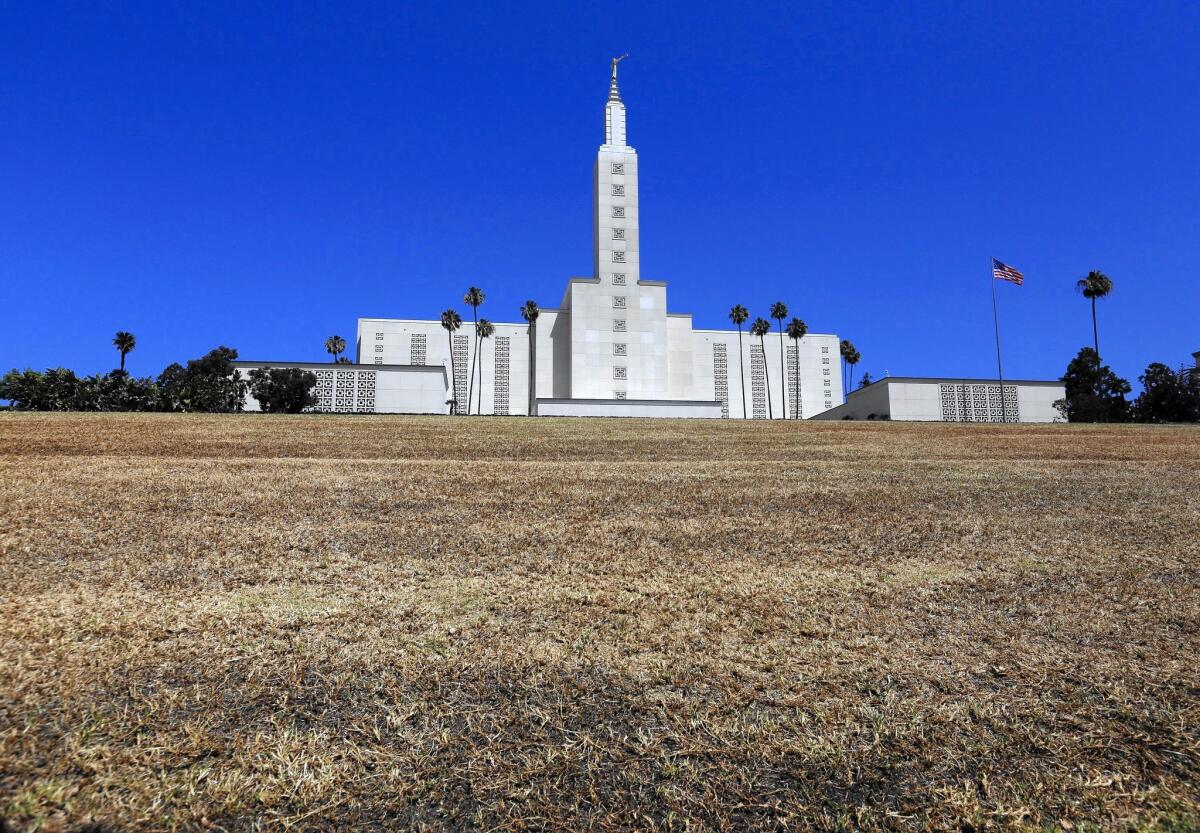Mormon Temple in West L.A. lets its landmark lawn turn brown

The once-green grass in front of the Mormon Temple on Santa Monica Boulevard in West L.A. has become parched since the church stopped watering it about a month ago because of the drought.
- Share via
Bob and Carolyn Millard were married at the Church of Jesus Christ of Latter-day Saints’ palatial Westwood temple more than 50 years ago. Like many other Mormon brides, Carolyn posed for photos alongside the temple’s lush, green lawn and gardens.
When she visited the temple last week, Millard was struck by the sight of the hillside expanse that extends down to Santa Monica Boulevard. It was mostly patchy and brown.
Her first thought: “The drought!” Her next thought: “The brides! I can’t imagine seeing a bride taking pictures with brown grass.”
The browning lawn is part of an effort by church officials to save water, transforming one of West Los Angeles’ most visible landmarks into a stark symbol of how California’s drought is beginning to affect the landscape of Southern California and the behavior of its residents.
The temple, which sits on a 13-acre site, was the first Mormon temple built in California, dedicated in 1956. The usually green hillside is well known by Westside motorists.
Jarom Ellsworth, a security guard at the temple, said the gardeners had stopped watering the lawn about a month ago to conserve water.
Normally, he said, gardeners remove thatch from the lawn once a year in the winter, but because they had stopped watering, he said they decided to dethatch it now. He said they will then resume watering the lawn a little until it is green again.
“They’re going to stop once it comes up a little bit, just so it’s not so brown and ugly,” he said. “We’ve had a lot of questions about it, but then they understand once they know it’s because of the drought.”
Church officials could not be reached for comment.
A volunteer at the Mormon church on Ohio Avenue, near the temple, said church members have been asking whether the temple’s browning front lawn was a drought measure.
Carolyn Millard said the temple lawn and gardens have been lush and beautiful for as long as she could remember because “it is a sacred place, a holy place.” Keeping the grounds beautiful, she said, is out of reverence to God.
The temple’s move to reduce water consumption comes as state and local officials step up pressure on residents to cut back on water usage. West Los Angeles and other affluent communities have been under particularly intense scrutiny. A recent UCLA study that examined a decade of Department of Water and Power data found that on average, wealthier neighborhoods consumed three times more water than lower-income areas.
Data on individual utility customers’ water usage is not public under state law, making a more detailed analysis of the biggest users difficult.
In response to growing concerns about water usage, Beverly Hills last week approved new rules intended to help the city cut its water use by more than a third by February. Under the new requirements, residents can be fined up to $1,000 for draining and refilling swimming pools, washing cars at home with potable water or watering their lawns more than two days a week.
Stephanie Pincetl, director of the California Center for Sustainable Communities at UCLA, said the move by the Mormon Church could serve as an important signal to other water users.
“I think what it does is it provides some leadership in the sense of, they’ve taken it seriously, it’s possible to do it, and others should,” she said.
A Mormon family attending a Sunday service at the Ohio Avenue church had taken note of the temple’s parched lawn. Kyle Casey, 21, of Layton, Utah, who had served as a missionary at the Los Angeles temple and nearby church for two years, recalled helping to pull up and re-sod parts of the lawn to keep it pristine.
“I like it green,” Casey said. “But it’s fine yellow too. California has a desert feel.”
More to Read
Sign up for Essential California
The most important California stories and recommendations in your inbox every morning.
You may occasionally receive promotional content from the Los Angeles Times.












